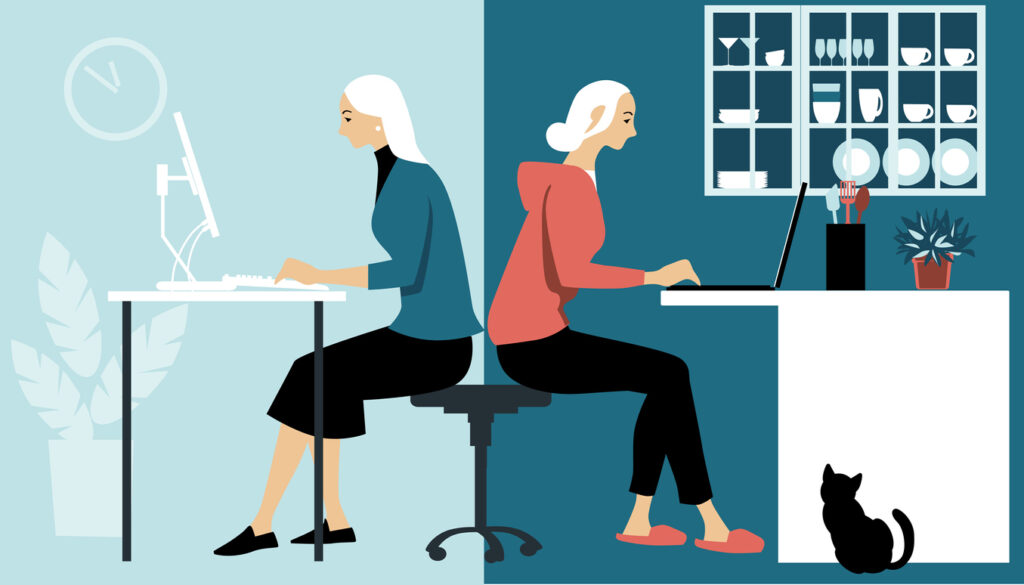If the only change we make to our workplace practices post-Covid is the introduction of hybrid working, then we are missing a huge opportunity – and could even be risking turning the clock back on the progress that was made on flexibility pre-pandemic.
This could be detrimental for many disabled people, working parents and carers who need greater flexibility. It could also become even more difficult to recruit. So, if we are looking for a new norm, hybrid working is only one small part of the solution. What we really need is inclusive working.
What is inclusive working?
Hybrid working focuses on ‘where’ people work. Inclusive working focuses much more holistically on ‘how’, ‘when’ and ‘where’ people work. Inclusive working is about helping people to be as engaged and productive as possible, by allowing them the flexibility to work in a way which best suits their needs.
For one person, it might be being able to flex their working hours as and when needed – for example to manage fatigue, pain, or caring responsibilities
This means that inclusive working will be different for each person. For one person, it might be being able to flex their working hours as and when needed – for example to manage fatigue, pain, or caring responsibilities. For another person, it might be flexibility or choice of location – the office for example, or home, or a shared space or for being able to work entirely remotely wherever they choose.
The challenge for employers
A focus on individuality is the point of inclusive working – and also the difficulty for businesses working out how to re-engineer a world of work post Covid-19. Of course, businesses need to balance individual needs with the overall business needs.
There is no one perfect answer – or even yet a sense of what good truly looks like. Everyone has their own interpretation and organisations who get it right need to focus on finding the ‘sweet spot’ between personal and organisational preferences.
There are also big questions about ‘global’ consistency vs ‘local’ flexibility and to what extent we need to codify rules vs giving autonomy to individuals/managers to decide what works. What all seem to agree on though is that when teams come together, it needs to be purposeful – and that we need to empower and trust people to do what’s right.
The risk that hybrid working poses
Hybrid working can bring many benefits – allowing people to benefit from working in different locations and blending the social aspects of being in the workplace balanced with greater flexibility of working from home. The issue is that these benefits risk being undermined by rigid, one-size-fits all policies which often dictate how many days, or even hours, each person in an organisation can spend working at home or in the workplace.
We have already heard some truly daft arrangements in the name of hybrid – one example where an employee was required to come into the office for two hours but no longer as the desk was re-allocated to another employee after that. That may technically be hybrid, but it’s not inclusive, not flexible and I would be very surprised if it is productive!
Inclusive working isn’t about everyone just doing their own thing. It’s about having flexible policies which enable employees to be as productive as possible
Though that may be an extreme example there are many more; where someone pre-pandemic may have been allowed to work at home every Monday due to caring responsibilities, they are now being told which days they have to be in the office as part of the organisation-wide plan – which may or may not be compatible with their caring roles.
Others who prefer to work in the office more because space at home is limited, they prefer the social interaction, like the work/life separation or simply feel that makes them more productive, are being told that there simply aren’t the desks available. According to The Guardian, some projections suggest that by 2027, one in 10 office spaces in Britain will no longer be needed.
And for those who do work from home, research suggests they could be working more hours than they were pre pandemic. We see that the blurring of lines between work and home and an ‘always on’ culture is contributing to burnout and exhaustion, and risks seriously impacting employee health.
Inclusive working: The role of HR
So how do we achieve inclusive working and how can HR drive the change?
- Start from a point of trust. Inclusive working isn’t about everyone just doing their own thing. It’s about having flexible policies which enable employees to be as productive as possible.
- Treat people as individuals. Blanket policies are often built on assumptions. Instead, ask colleagues what they need and make this a regular conversation.
- Consult with your disability networks about the impact of company-wide policies while you are developing them – and before you introduce them.
- Equip line managers with the skills, confidence, and autonomy to be able to offer real flexibility to their teams.
- Allow staff to ‘co-create’ their own jobs with the support of line managers and in line with company policies, as advocated for in the BITC’s ‘What if your job was good for you?’ report
- Gain senior buy-in. Inclusive working involves the whole organisation. Having senior leadership driving and role modelling what it looks like is vital.
We mustn’t waste this opportunity to get it right. We have seen great change over the last two years, so we know how quickly change can be achieved when needed.
Inclusive working is individual and therefore messier, trickier and more complex to get right
Hybrid is one new way of working, but it won’t suit everyone – and it too often does the exact opposite of its intention by simply replacing one set of (pre pandemic) rigid rules with another.
Inclusive working is individual and therefore messier, trickier and more complex to get right. But we need to embrace it if we are truly to realise the ambition to Build Back Better and create a new world of work that works for everyone. We’ve learned to trust people during the pandemic. Let’s not lose that.
Interested in this topic? Read Leadership in the hybrid world of work.
[cm_form form_id=’cm_65a14c3f5da64′]






